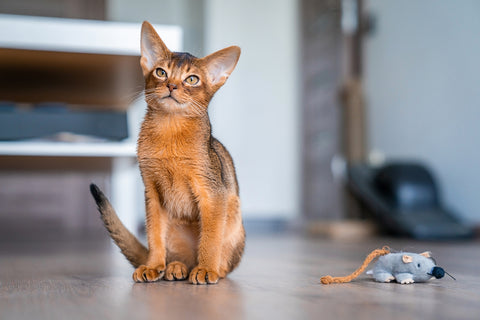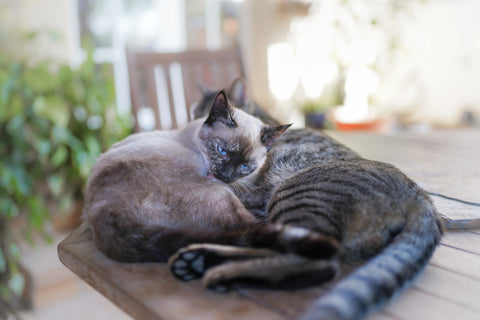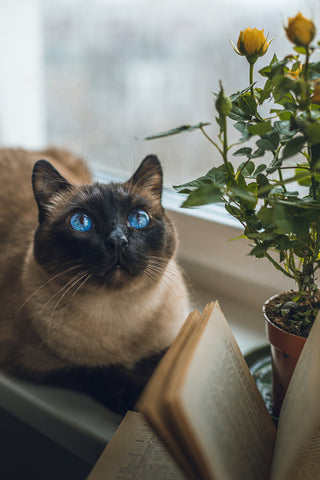
If your beautiful feline’s eyes are two different colors – yellow and blue perhaps – then you’ve got yourself an odd-eyed kitten! These captivating little creatures are carriers of a feline form of a condition known as complete heterochromia. Heterochromia in cats is a captivating genetic anomaly most commonly observed in white kitties.
About your kitty’s eyes
A cat’s eyes are significantly large in comparison to the size of its head. This is actually a key feature of all nocturnal animals. The actual eyeballs are placed in bony cavities called the orbits. The white part of the eye is called the sclera , and it’s covered with a thin membrane called the conjunctiva. The conjunctiva covers the inside of the eyelids. In front of the eye is a clear dome cornea. The cornea protects the eye and lets light in. The round, colored area of the eye is the iris.
Light enters the eye through the pupils (the black area at the center of the eyes). Pupils are very sensitive to light changes, and they adjust to them accordingly. In high abundance of light, a cat’s pupils appear elliptical, while in darker conditions they are round, almost filling the entire iris area. The smaller the pupil, the less light comes in, and vice versa. Domestic cats typically have vertical slit pupils. However, there are some big cats, such as Siberian tigers, who have circular pupils, similar to us. It is widely accepted that the feature of vertical eyes is an adaptation to a nocturnal lifestyle, as this pupil shape excludes light more effectively. Vertical pupils also change size much faster than round pupils.

Behind the iris sits the lens. Lining the back of the eye is a light-sensitive tissue called the retina. Light focuses on the retina through the cornea, pupil and lens. It is the retina that will convert the light rays into nerve impulses and send them to the brain. The brain interprets these impulses and forms an image (Gelatt, Baker, & Eugster, 2018).
Eye colors
The iris in domestic felines may vary in pigmentation from blue and green tones to yellow and brown. These colors are not discrete, but rather a continuum between tones. Sometimes, eye colors are linked to coat color or breed. For example, Siamese cats always have blue eyes. Generally speaking, pedigreed cats tend to have more vivid and distinct eye pigmentations due to selective breeding.
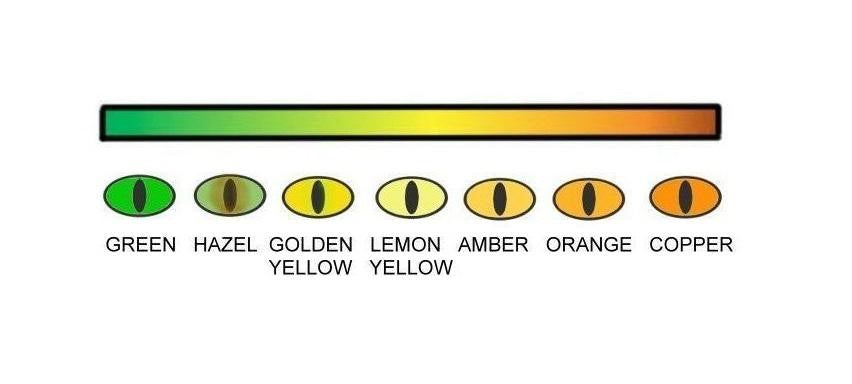
Figure 1: The common continuum of eye colors in cats (source)
How do eyes get their color though?
Eye pigment is produced by pigment-producing cells called melanocytes, which are present in the iris. The exact color and its intensity will depend on the number and activity of melanocytes in the iris. If there are no melanocytes, the eye will be blue. A low abundance of melanocytes results in green coloration, and a high abundance of melanocytes creates an orange color. If the melanocytes are less active, the intensity of the given color will be lighter and vice versa. Therefore, eyes with a high number of melanocytes (orange) can range from amber (less active melanocytes) to strong copper (active melanocytes).
The activity of melanocytes is genetically determined. Multiple genes in different chromosome locations are in control of the iris pigmentation (Bishko, 2011).
Heterochromia in cats
Odd eyes, or heterochromia iridium, can be genetic, congenital or acquired. This is a condition most commonly seen among white-colored felines but may appear in all other cats who carry the white spotting gene too.

Heterochromia in cats: British Shorthair supermeowdel Starina @starinaesperanza
The cause of odd eyes
Odd eyes can be inherited from parents (genetic) or acquired due to certain illnesses, injuries, and medications. Acquired odd eyes cannot be passed on to the kittens. However, most commonly, odd eyes are congenital (associated with development defects).
How do congenital eyes form?
During development, stem cells are migrating to a different part of the body where they differentiate into specialized types of cells. Some of these stem cells migrate through the embryo and stop in the eye, where they become melanocytes. In certain conditions, melanocytes are prevented from reaching one of the eyes. This results in one eye having melanocytes which will give it its pigmentation (green, amber, or brown), while the other eye will remain blue due to the lack of melanin.

Heterochromia in cats: Sisters from Saint-Petersburg, Russia: Iriss and Abyss @sis.twins
This usually happens in solid white or white spotted cats (bicolor and tuxedo). The dominant white gene (the gene that makes the cats completely white) and the white-spotting gene (the gene that makes the cats white-spotted) sometimes interfere with the migration of melanocytes into one of the eyes. This condition doesn’t occur very often in cats that lack these two genes. In non-white cats, odd eyes are often a result of differently developed eyes in the embryo. These congenital odd eyes are hereditary and may be passed on to the cat’s kittens (Bishko, 2011) (Wenger, 2009).
Odd eyes and deafness
Deafness in white cats seems to be associated with the white spotting gene and dominant white gene, but not with the albino white gene. Deafness in white cats is more common among those cats with blue eyes or with heterochromia. This is because the white gene can occasionally cause the degradation of the cochlea aside from disrupting melanocyte migration into one or both eyes. The cochlea is the part of the inner ear involved in hearing. This results in irreversible deafness in one or both ears (Starbuck & Thomas, 2004).
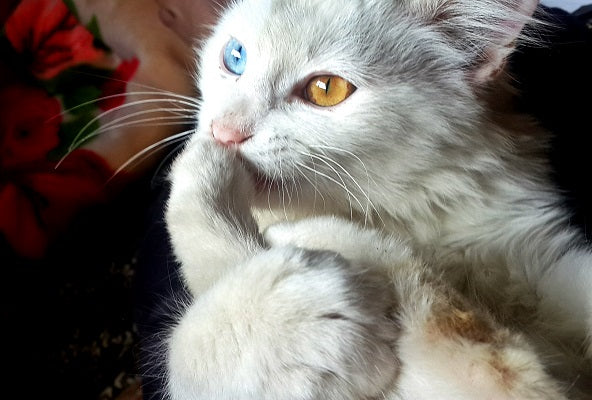
Did you know?
1. Cats have a visual field of view of 200°, compared to human’s 180°.
2. Cats don’t need to blink regularly like us. This is considered an advantage when hunting. They do “squint”, however, usually as a way of communication with other cats and humans.
3. They have a third eyelid! The nictitating membrane, or the third eyelid, is a thin membrane that closes from the side of the eyes. You can usually spot it when your feline is sleepy or sick. It’s also briefly visible when the eyelid opens.
4. Cats aren’t color blind. Cats can recognize red, blue and yellow lights and can also distinguish between red and green tones.
5. Cats do not see in complete darkness. But they do see well in very low light. The reasons they see better in darkness than us, mere humans, are because 1) they have more rods (they can therefore detect more light than us) and 2) they have a tissue in the back of the eyes called tapetum lucidum. This tissue reflects the light within the eye and it’s also what makes their eyes shine in the dark.
6. Odd eyes are a national treasure in Turkey. Turkish folklore suggests that “the eyes must be as green as the lake and as blue as the sky”, and since 1817, the Turkish Angora (a pure white cat with blue and amber odd eyes) has been bred through a breeding program aiming to preserve and protect this trait.

Cats are captivating and wonderful. We would all love to see what the world looks like through the eyes of our little furriends, but today, we have to settle for just a little bit of science behind heterochromia in cats.
Your cat's DNA make-up matters. All the information required for the functioning of every little bit of your cat's body is written in the genes. Luckily, with Basepaws, discovering your cat's genetic background, ancestry, and health predispositions has now become a lot easier and less expensive than ever.
References:
- Bishko A. (2011). What Your Cat’s Body Language Is Saying. Retrieved April 2018, from WebMD
- Hughes A. (1975). A quantitative analysis of the cat retinal ganglion cell topography. J. Comp. Neurol. 163 (1): 107–28.
- Gelatt K., Baker D. & Eugster A. (2018). Eye Structure and Function in Cats. Retrieved from MSD MANUAL Veterinary Manual
- Guenther E, Zrenner E. (1993). The Spectral Sensitivity of Dark- and Light-adapted Cat Retinal Ganglion Cells. Journal of Neuroscience. 13 (4): 1543–1550.
- Starbuck O. & Thomas D. (2004). Cat Color FAQS: Cat Color Genetics. Retrieved from CatFanciers.com
- Wenger, J. (2009). Conditions. Retrieved from: thetech.org

